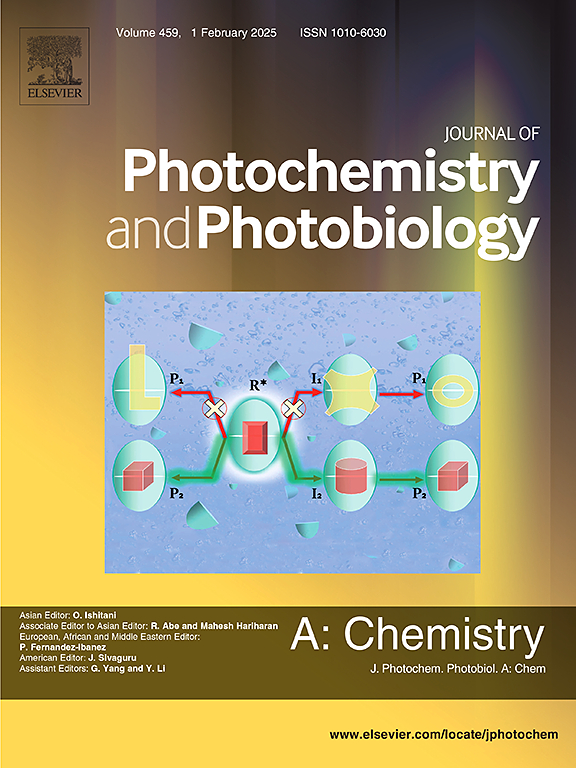Near-Infrared absorbing A–π–D–π–A small molecule Driven by simple intramolecular noncovalent Bonds for efficient organic solar cells with enhanced visible transmittance
IF 4.1
3区 化学
Q2 CHEMISTRY, PHYSICAL
Journal of Photochemistry and Photobiology A-chemistry
Pub Date : 2025-04-21
DOI:10.1016/j.jphotochem.2025.116449
引用次数: 0
Abstract
Semitransparent organic solar cells are among the most promising solar cell technologies for applications in building-integrated photovoltaics (BIPV), agricultural greenhouses, and wearable energy harvesting, offering a balance between power conversion efficiency (PCE) and optical transparency. In this study, we designed and synthesized a cyclopentadithiophene (CPDT) core-based NIR absorbing NFA named CETIC for efficient organic solar cell with notably enhanced visible transparency. Employing a CPDT donor core with a 1-(dicyanomethylene)-3-indanone acceptor connected with a functional thiophene π-bridge potentially enhances the intramolecular interaction to achieve planar molecular geometry. The champion devices based on PM2:CETIC deliver an efficient PCE of 7.93 % with a Voc of 0.88 V, a Jsc of 15.52 mAcm2, and a fill factor (FF) of 58 %. Our work reveals molecular design strategy by rationally establishing multiple strong noncovalent intramolecular interaction between donor and π-bridge to enhance the PCE and transparency for potential application in semitransparent organic solar cells.

由简单的分子内非共价键驱动的近红外吸收A -π-D -π-A小分子,用于提高可见光透过率的高效有机太阳能电池
半透明有机太阳能电池是应用于建筑集成光伏(BIPV)、农业温室和可穿戴能源收集的最有前途的太阳能电池技术之一,它在功率转换效率(PCE)和光学透明度之间提供了平衡。在这项研究中,我们设计并合成了一种基于环戊二噻吩(CPDT)核的近红外吸收NFA,命名为CETIC,用于高效有机太阳能电池,具有显著提高的可见光透明度。采用CPDT供体核与1-(二氨基乙烯)-3-吲哚酮受体连接的功能噻吩π桥可能增强分子内相互作用,以实现平面分子几何结构。基于PM2:CETIC的领先器件提供了7.93%的高效PCE, Voc为0.88 V, Jsc为15.52 mAcm2,填充因子(FF)为58%。我们的研究揭示了通过合理地建立供体和π桥之间的多个强非共价分子内相互作用来提高PCE和透明度的分子设计策略,为半透明有机太阳能电池的潜在应用提供了可能。
本文章由计算机程序翻译,如有差异,请以英文原文为准。
求助全文
约1分钟内获得全文
求助全文
来源期刊
CiteScore
7.90
自引率
7.00%
发文量
580
审稿时长
48 days
期刊介绍:
JPPA publishes the results of fundamental studies on all aspects of chemical phenomena induced by interactions between light and molecules/matter of all kinds.
All systems capable of being described at the molecular or integrated multimolecular level are appropriate for the journal. This includes all molecular chemical species as well as biomolecular, supramolecular, polymer and other macromolecular systems, as well as solid state photochemistry. In addition, the journal publishes studies of semiconductor and other photoactive organic and inorganic materials, photocatalysis (organic, inorganic, supramolecular and superconductor).
The scope includes condensed and gas phase photochemistry, as well as synchrotron radiation chemistry. A broad range of processes and techniques in photochemistry are covered such as light induced energy, electron and proton transfer; nonlinear photochemical behavior; mechanistic investigation of photochemical reactions and identification of the products of photochemical reactions; quantum yield determinations and measurements of rate constants for primary and secondary photochemical processes; steady-state and time-resolved emission, ultrafast spectroscopic methods, single molecule spectroscopy, time resolved X-ray diffraction, luminescence microscopy, and scattering spectroscopy applied to photochemistry. Papers in emerging and applied areas such as luminescent sensors, electroluminescence, solar energy conversion, atmospheric photochemistry, environmental remediation, and related photocatalytic chemistry are also welcome.

 求助内容:
求助内容: 应助结果提醒方式:
应助结果提醒方式:


